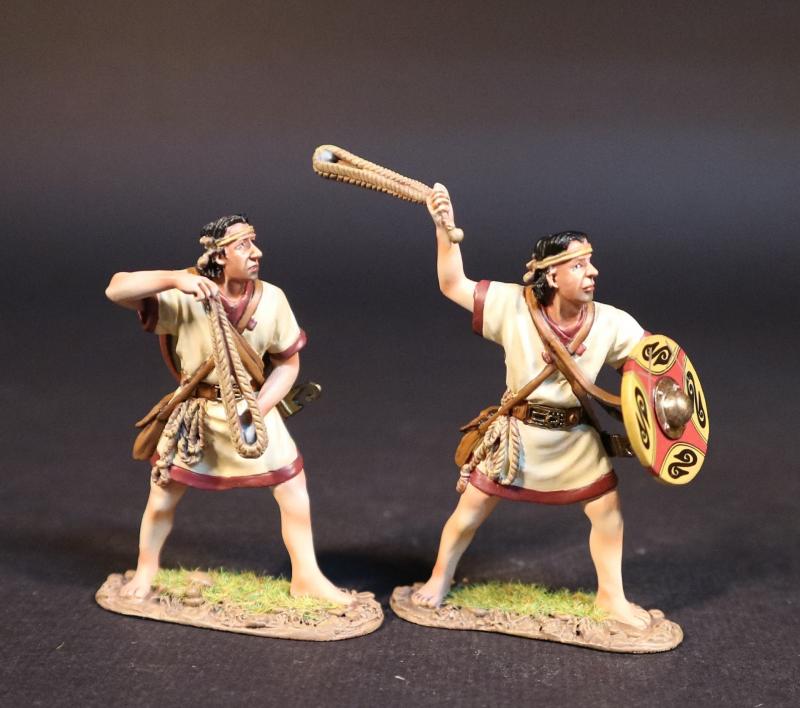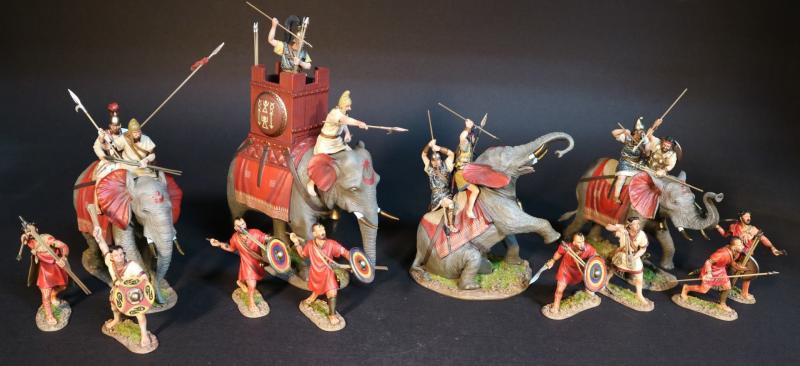Balearic Slingers, The Carthaginians, The Battle of Zama, 202 BCE, Armies and Enemies of Ancient Rome--two figures (standing loading, wearing shield and winding up
$98.00
Item Number: CTSK-04
Balearic Slingers, The Carthaginians, The Battle of Zama, 202 BCE, Armies and Enemies of Ancient Rome
ARMIES AND ENEMIES OF ANCIENT ROME
THE CARTHAGINIANS
THE BATTLE OF ZAMA, 202 BCE
Carthage learnt the use of elephants from fighting in Sicily against Pyrrhus of Epirus between 278 and 276 BCE. The Carthaginians quickly realized they could easily acquire African Forest Elephants which inhabited North Africa in great numbers. It was much easier to capture these elephants than import elephants from India.
It was not long before Carthage had the most powerful elephant corps in the Mediterranean world, with stables housing up to 300 elephants located in the capital. They would replace chariots as the Carthaginian’s main striking force.
The elephants primarily used by the Carthaginian armies were of the now extinct smaller African kind. They stood between 2m and 2.5m tall. These elephants were taken from the now long vanished forests of Numidia. Their primary use was to terrify the uninitiated man and horse, and they carried a single rider known as a mahout, who was armed with a javelin. Each elephant could also carry an additional soldier armed with javelins or a long spear.
It is believed that the elephants deployed at Zama did not carry infantry in howdahs on their backs. Most scholars doubt it as the forest species being smaller than Asian elephants, it is believed could not carry the additional weight. Any elephants with towers were believed to have been imported from India. However, the Egyptian Ptolemies as well as Numidian kings are recorded as having put towers on forest elephants, and the Roman poet Juvenal mentions towers on Hannibal’s elephants.
In 218 BCE, the Second Punic War began and the famous Carthaginian general Hannibal traversed the Alps to invade Italy with an army that included 37 war elephants, which were believed to be mostly African. In the course of that arduous crossing, many men, cavalry and draught animals were lost, but apparently (according to ancient sources) not a single elephant. The elephants were to contribute to Hannibal’s first victory in Italy, on the Trebbia river, where they frightened the Roman cavalry and routed the Roman auxiliaries. Shortly after the battle, all but one elephant died. It is not known why? Maybe the after effects of exhaustion suffered during the crossing, or some disease incurred during the campaign, are all distinct possibilities.
NORTH AFRICAN ALLIES
Although initially the Carthaginian army was composed only of Citizens of Phoenician origin, it saw increased recruitment of contingents of mercenaries and allies a necessity in order to realize the policy of imperial expansion. This use of mercenaries saved the metropolitan population from heavy casualties that were not easily replaceable, and it also reflected the Carthaginian concept of war, which was considered simply as an extension of business. With the enlargement of Punic economic interests the army became more exclusively mercenary and progressively came to include almost all the peoples of the central and western Mediterranean area.
The largest single component of the Punic army usually comprised soldiers recruited or impressed from subject Libyans. These are often referred to as “Africans”, or Liby-Phoenicians. These were mercenaries or in some cases conscripts, subject to service from the tenants of the large African estates. Eventually these mercenaries were no longer simply troops hired for a single campaign and discharged after a few months service, as had originally been the case, especially during the first Punic War. They were now a professional standing army seasoned by long years of warfare, under the command of skilled generals such as Hamilcar Barca and his sons.
Among the North African allies were the subjected Libyans of the Marmarica, which formed a major part of the light infantry. These were mainly made up from several tribes, Nasamones, Macae from the Cynips river, the tribes of Barce, the Autololes, the ferocious Adyrmachidae, and the Garamantians.
BALEARIC SLINGERS
The Balearic Islands are a Spanish archipelago in the Mediterranean Sea. Today, these islands are best known as tourist destinations, with the islands of Ibiza and Mallorca being especially popular.
However, in antiquity, the Balearic Islands were best known for the deadliest slingers in the Mediterranean. The Balearic slingers were a coveted asset of every army of antiquity.
The name for the Balearic Islands originated from the Greek word “ballo” which means “to launch.”
The Balearic slingers started training as soon as they could walk. Supposedly, mothers didn’t give their children food until they could hit their targets. Years and years of practice made slinging their second nature and turned these slingers into game-changing warriors on the battlefield.
During the second Punic War (218-201BCE), the Carthaginian master general Hannibal wreaked havoc in Roman Italy. The Romans were terrified of the invisible killers, the Balearic slingers.
The Carthaginians recognized the skill of the slingers and tried to hire as many of them as possible. Interestingly the slingers didn’t want gold: they demanded to be paid with wine and women.
Once the Romans defeated the Carthaginians, they made sure that the Balearic slingers became part of the auxiliary units of the Roman legions.
The use of slings slowly faded away. It took years and years of practice to train warriors to efficiently use this weapon. In the Middle Ages, bowmen required less effort to train than slingers. Eventually, bows were replaced by firearms, the usage of which could be taught in a matter of weeks.
We could say technological advancement made the Balearic slingers obsolete. However, history will remember them for their skills, terrifying reputation, and admiration from foes and friends alike.
The Balearic slingers launched bullets that had a speed of 160 kilometers per hour (one hundred miles per hour). They could hit their opponents at a distance of 400 meters (1,300 feet), but were deadliest at a distance of 120 meters (400 feet).
An experienced slinger could make seven shots per minute.
They carried three slings, one around their head, one around their waist, and the third in their hands. Different slings were used to hit targets at different distances. The longer the sling, the larger distance it could cover.
They manufactured the bullets for slings from stone, lead, or clay. Some sling bullets had holes to give off a buzzing sound, reminiscent of an agitated wasp. This was an ancient form of psychological warfare.
Often, the bullets contained inscriptions and images. The most common were the images of a lightning bolt, a snake, or a scorpion. Some bullets had inscriptions such as: “Take this”, “Catch”, “Ouch”, or “Get pregnant with this.
Due to be released in JUNE 2024.

